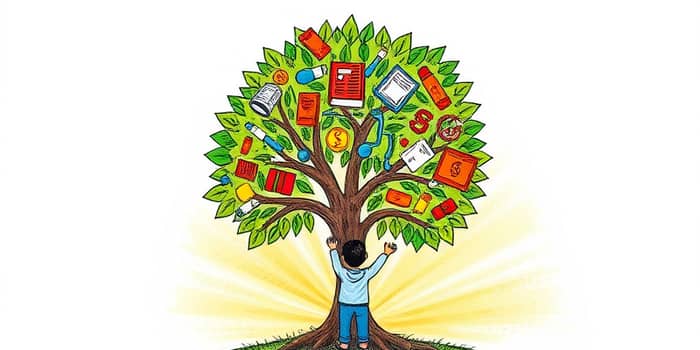Investing in your personal growth yields rewards that far exceed any traditional portfolio. By dedicating time, effort, and resources into your own development, you unlock potential that compounds throughout your life.
Meaning and Scope of “Investing in Yourself”
At its core, investing in yourself means prioritizing activities that enhance your abilities, well-being, and financial acumen. This multi-faceted approach spans education, health, personal development, financial knowledge, and productivity techniques.
- Education and upskilling: degrees, certifications, continuous professional learning
- Health and well-being: fitness routines, preventive healthcare, mental health support
- Personal development: soft skills, networking, pursuing passions
- Financial literacy: learning to manage and grow personal finances
- Time management and productivity: adopting methods to optimize daily efficiency
The Classic Financial Returns: Market Benchmarks
Understanding standard market returns helps contextualize the value of self-investment. Over the long term, the S&P 500 has delivered a nominal average return of 10–11% annually. Inflation-adjusted, that figure is closer to 6.86% or around 7% annually. From 2015 to 2024, the S&P 500 achieved an annualized return of 13.3%, while broader indices like the Russell 3000 produced 12.55%, and the Russell 2000 yielded 7.82%.
Private equity projections for 2025–2035 estimate a 13.5% annualized return. Even in turbulent periods, a disciplined equity investor growing $10,000 from 2000 to 2020 saw it become $31,200, reflecting a 5.9% inflation-adjusted rate. These benchmarks reveal the power of compound interest and resilience over decades.
The Financial Returns of Investing in Yourself
When you channel resources into your own capabilities, the dividends can be equally or even more impressive than market gains. Consider the lifetime earnings differential: in the US, a bachelor’s degree holder earns about $1.2 million more than someone with only a high school diploma. That gap reflects not just a higher salary but also reduced unemployment and greater career stability.
Regular skill enhancement leads to promotions, salary increases, and the ability to pivot into emerging industries. consistent, deliberate self-investment pays dividends over a multi-decade career, often outpacing any single stock or mutual fund purchase.
Health investments further amplify these gains. Employees participating in wellness programs report higher productivity and fewer sick days. Every dollar spent on wellness has been shown to return $3.27 in reduced healthcare costs and $2.73 in lower absenteeism. Over a lifetime, better physical and mental health translates into more active working years and a richer personal life.
Financial literacy is another cornerstone. Those who set clear investing goals are significantly more likely to contribute to retirement accounts and build wealth. In 2025, 28% of Americans set investing goals, yet only 24% have contributed to a retirement plan this year, highlighting a gap that education can bridge. wealth accumulation and reduced debt come hand in hand with informed decisions and disciplined saving.
Psychological and Non-Monetary Returns
Beyond quantifiable returns, investing in yourself nurtures intangible assets: confidence, resilience, and a sense of purpose. Individuals who maintain a mindset of continuous improvement demonstrate greater adaptability during market downturns and life setbacks.
Research shows self-directed investors feel empowered during economic volatility, often acting on downturns instead of withdrawing. increased confidence and reduced anxiety arise from knowing you have the skills and knowledge to navigate change and seize opportunity.
Compounding Effect Analogy
The concept of compound interest in finance has a parallel in personal growth. Small, consistent efforts—like daily reading, short workouts, or micro-investments—combine over time into profound transformations. Just as financial capital grows exponentially with reinvested dividends, your abilities, health, and networks expand in capability and impact.
Early and steady self-investment often leads to early investment yields disproportionately high returns later in life. By age 30, someone who began professional learning at 18 can have a decade of advanced credentials and experience compared to peers, positioning them for leadership roles and entrepreneurial ventures.
Societal and Economic Impact
Personal investments collectively elevate communities and economies. A workforce rich in skills and well-being drives innovation, productivity, and GDP growth. Companies reap rewards through reduced turnover, lower healthcare expenditures, and a culture of continuous learning.
On a societal level, higher education attainment correlates with greater civic engagement, lower crime rates, and improved public health. These broader societal and economic benefits ripple across generations, creating a virtuous cycle of progress.
Barriers and Motivation
Despite clear advantages, many obstacles impede self-investment. Common barriers include lack of time, tight budgets, fear of failure, market volatility concerns, and existing debt. Data shows 20% of Americans worry about market swings, while 19% cite debt as a major deterrent.
Conversely, motivators such as greater future earnings and security, personal satisfaction, and resilience in adversity drive individuals to act. Recognizing these motivators and addressing barriers through small, structured steps can spark momentum and sustain progress.
Actionable Steps
Transform intention into action with these practical measures:
- Enroll in an online certification or skill-building course.
- Commit to a fitness or mental wellness routine.
- Allocate weekly time for reading, networking, or creative pursuits.
- Open or contribute to retirement and investment accounts, even modestly.
- Track progress quarterly, adjusting goals and strategies.
Useful Statistics and Takeaways
Below is a summary of key benchmarks and impact metrics to guide your planning:
By viewing personal growth as a strategic investment, you position yourself to reap both financial and non-financial returns that resonate across your career, health, and community. Embrace the journey of self-investment—your greatest asset is you.
References
- https://moneywithkatie.com/blog/where-the-7-percent-return-comes-from-in-investing
- https://www.businessinsider.com/personal-finance/investing/average-stock-market-return
- https://newsroom.fidelity.com/pressreleases/-new-data-from-fidelity-investments--reveals-confidence-among-self-directed-investors-despite-tumult/s/46faefed-b826-4a16-a1b3-3ff9a6a2cf41
- https://www.adamsstreetpartners.com/insights/2025-global-investor-survey/
- https://www.schwab.com/learn/story/schwabs-long-term-capital-market-expectations
- https://www.nerdwallet.com/article/finance/2025-financial-goals-midyear-check-in-report
- https://www.blackrock.com/us/financial-professionals/insights/investment-directions-fall-2025










